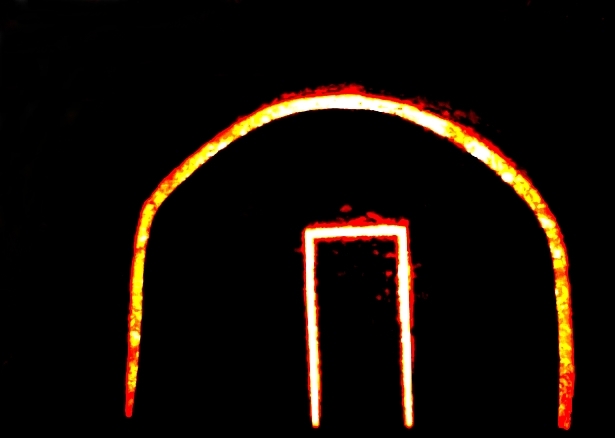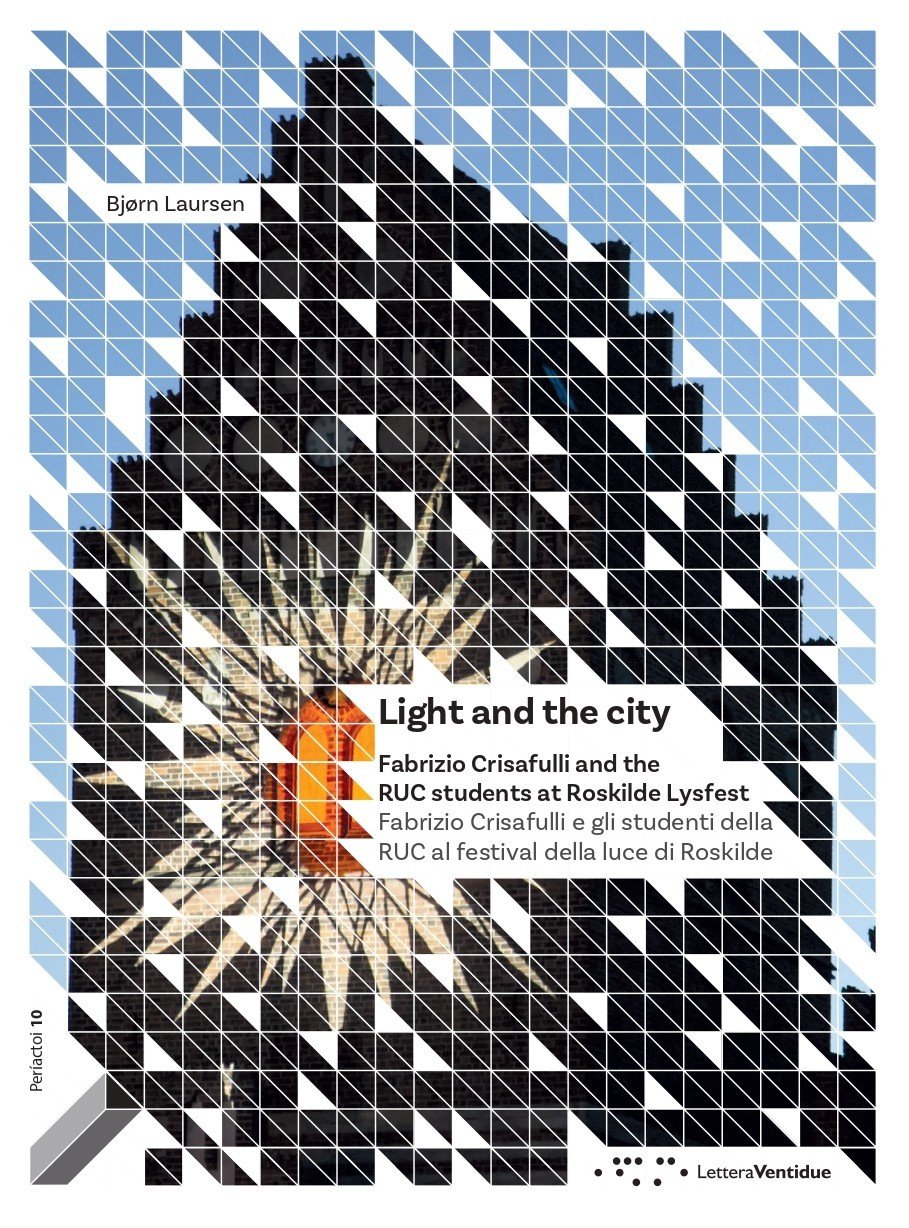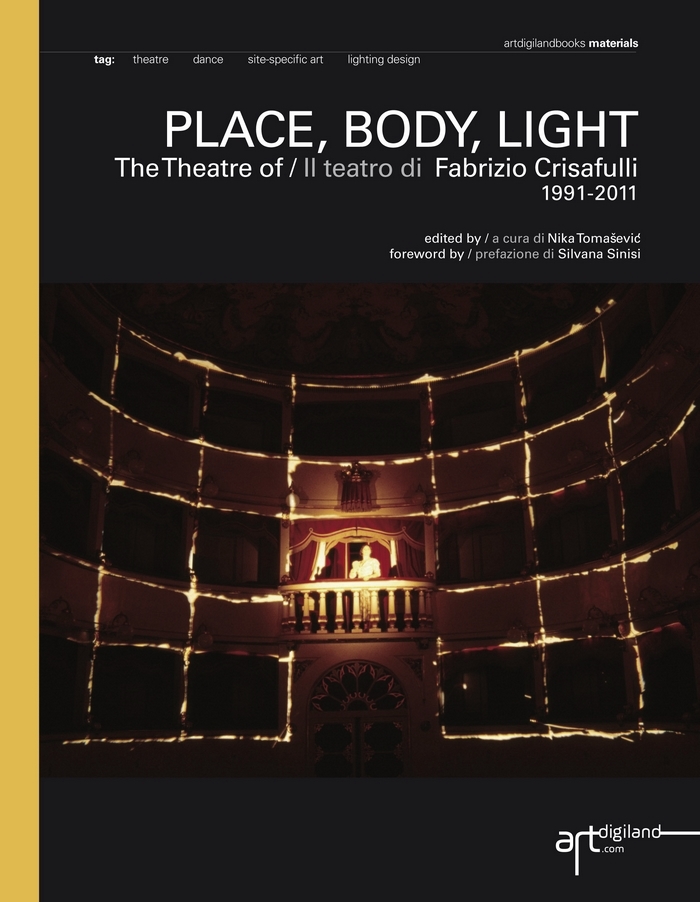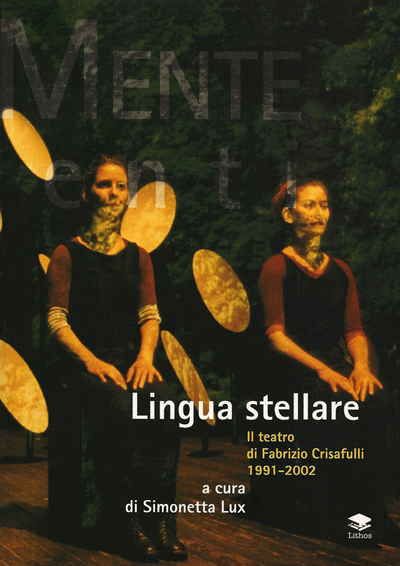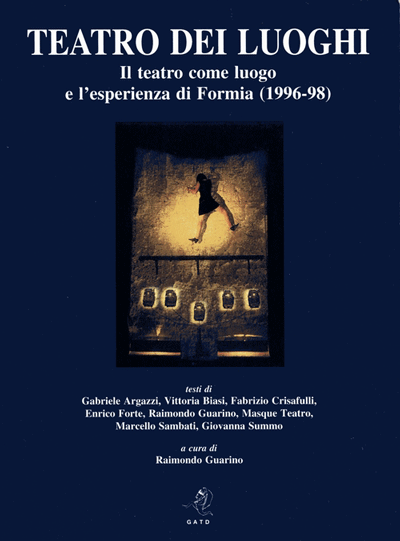BOOKS ON FABRIZIO CRISAFULLI'S WORK
Nika Tomasevic (ed.), Place, Body, Light. The Theatre of Fabrizio Crisafulli, 1991-2022, foreword by Silvana Sinisi, updated and augmented edition, Dublin: Artdigiland 2022 (pp. 498, illustrated, ENGLISH/ITALIAN)
Bjørn Laursen (ed.), Light and the City. Fabrizio Crisafulli and the RUC students at Roskilde Lysfest, Syracuse (Italy): Lettera Ventidue 2022
(pp. 128, illustrated, ENGLISH/ITALIAN)
Paola Paesano (ed.)
Luce Materia Tempo. Proiectum: n’installazione di Fabrizio Crisafulli e Federica Luzzi,
testi di Fabrizio Crisafulli, Giuseppe Garrera, Federica Luzzi, Patrizia Mania, Monica Vacca
Interventi di Marina Benedetto, Alvin Curran, Claudio Damiani, Melissa Lohman, Gaia Riposati, Beppe Sebaste, Stefania Soskic,
Biblioteca Vallicelliana, Roma, 2020
(pp. 152, illustrato, ITALIANO)
Patrizia Mania, Brunella Velardi (ed.)
DOPPIO MOVIMENTO DI FABRIZIO CRISAFULLI Arte contemporanea e siti storico-artistici,
Sette Città, Viterbo, 2020
(pp. 80, illustrato, ITALIANO)
Benedetta Mazzelli (ed.)
QUEL CHE HO VISTO E UDITO
Note sul teatro di Fabrizio Crisafulli
tra luce e parola
prefazione di Alberto Nannicini
testi di Fabrizio Crisafulli, Renzo Guardenti
Titivillus, Corazzano (PI), 2020
(pp. 256, illustrated, ITALIAN)
Alessandro Smorlesi (ed.)
IN FLAGRANTE
Il teatro di Fabrizio Crisafulli
incontra Yasunari Kawabata, 1995-2013
prefazione di Renzo Guardenti
Lettera Ventidue, Siracusa, 2018
(pp. 92, illustrato, ITALIANO)
Nika Tomasevic (ed.)
PLACE, BODY, LIGHT
The Theatre of Fabrizio Crisafulli, 1991-2011
foreword by Silvana Sinisi,
Dublin: Artdigiland 2013
(pp. 358, illustrated, ENGLISH / ITALIAN)
Silvia Tarquini (ed.)
FABRIZIO CRISAFULLI
Un teatro dell’essere
prefazione di Rossella Battisti
con un saggio di Renzo Guardenti
Editoria & Spettacolo, Riano (RM), 2010
(pp. 136, illustrato, ITALIANO)
Silvia Tarquini (ed.)
LA LUCE COME PENSIERO
I laboratori di Fabrizio Crisafulli
al Teatro Studio di Scandicci, 2004-2010
prefazione di Giuliana Videtta
con testi di Giancarlo Cauteruccio, Fabrizio Crisafulli, Cristina Grazioli
Editoria & Spettacolo. Riano (RM), 2010
(pp. 154, illustrato, ITALIANO)
Simonetta Lux (ed.)
LINGUA STELLARE
Il teatro di Fabrizio Crisafulli, 1991-2002
con testi di Fabrizio Crisafulli, Maria Pia D'Orazi, Dario Evola, Raimondo Guarino, Teresa Macrì, Patrizia Mania, Paolo Ruffini
Lithos, Roma. 2003
(pp. 248, illustrato, ITALIANO)
Raimondo Guarino (ed.)
TEATRO DEI LUOGHI
Il teatro come luogo
e l'esperienza di Formia, 1996-98
con testi di Gabriele Argazzi, Vittoria Biasi,
Fabrizio Crisafulli, Enrico Forte, Masque Teatro,
Marcello Sambati, Giovanna Summo
Gatd, Roma, 1998
(pp. 106, illustrato, ITALIANO)
SOLD OUT
Place, Body and Light are the terms on which Crisafulli's theatrical research is focused. It challenges performance practices at their very foundations, in an attempt to reclaim the original potency of theatre and its relevance and effectiveness in contemporary times. Crisafulli's works are poetic and visionary, hypnotic and deeply emotional, and produce imaginative exchanges between archetypes and the world as it is now. A career of intense research is revealed through interviews, personal accounts, reviews, information and photos related to performances and installations created between 1991 and 2022.
Luogo, Corpo e Luce sono i termini sui quali si incentra la ricerca teatrale di Crisafulli. Essa rimette in discussione dalle fondamenta le pratiche performative, per rivendicare l’originaria potenza del teatro e al contempo la sua rilevanza ed efficacia nella contemporaneità. Le opere di Crisafulli sono poetiche e visionarie, ipnotiche e profondamente emotive, e producono scambi fantastici tra archetipi e mondo attuale. Il suo intenso percorso di ricerca viene rilevato attraverso interviste, testimonianze, recensioni, informazioni e immagini relative a spettacoli e installazioni realizzati nel periodo 1991-2022.
How do darkness and democracy relate? Or education and the cosmos? These are two of the many questions raised, more or less implicitly, by this book, which connects pedagogy, urban planning, lighting design and performance. It concerns the Lysfest, the "Light Festival", which took place in the years 2013-2017, in Roskilde, the ancient Danish capital, today part of the Great Copenhagen, and in particular the work involved carried out by the Performance Design students from Roskilde University (RUC), with the support of their teachers and the city administrators, strongly inspired by the extraordinary work with light of Fabrizio Crisafulli, the Italian artist who played a leading role in the project and created works in its context: a pilot-experience gathering thousands of people in the dark, in front of the luminous works created in the old town, which aroused collaboration between university and the city, and concrete solutions for urban regeneration: a project – writes Joy Mogensen, Mayor of Roskilde during the Lysfest years, and then Danish Minister of Culture – “formed by frontrunners within a fusion of knowledge, cultural vision and democratic debate”.
Luce, Materia Tempo (Light Matter Time) is a book on Proiectum, an installation created in November 2019 by Fabrizio Crisafulli and Federica Luzzi at the Valliceliana Library by Francesco Borromini in Rome: «a sentimental and anti-rhetorical tribute to the great master of Baroque architecture […] a highly innovative work, which gives an advanced and profound interpretation of site-specific art […]. We would not be fascinated by the enchantment of this double dream if the authors were not so willing to let themselves be enchanted by the powerful calls of the place»
(Paola Paesano).
Libro dedicato a Proiectum, installazione realizzata nel novembre 2019 da Fabrizio Crisafulli e Federica Luzzi alla Biblioteca Valliceliana di Francesco Borromini a Roma: «un omaggio sentimentale e antiretorico al grande maestro dell'architettura barocca un'opera altamente innovativa, che offre un'interpretazione avanzata e profonda dell'arte site-specific […]. Non saremmo affascinati dall'incanto di questo doppio sogno se gli autori non fossero così disponibili a lasciarsi incantare dai potenti richiami del luogo»
(Paola Paesano).
The book describes and analyses the installation Doppio movimento (Double Movement), created by Fabrizio Crisafulli, in November 2018, on the facade of the Romanesque San Carlo church in Viterbo, and inside the same building. The event established a dialogue between contemporary art and historical-artistic heritage site; between past, present and future of the place; a dialogue which has put into play the place memoir and imaginary, in relation with the site identity and its perspectives.
Il libro descrive e analizza l'installazione Doppio movimento, realizzata da Fabrizio Crisafulli, nel novembre 2018, sulla facciata della chiesa romanica di San Carlo a Viterbo e all'interno dello stesso edificio. L'evento ha creato un dialogo tra arte contemporanea e patrimonio storico-artistico; tra passato, presente e futuro del luogo: un dialogo che ha messo in gioco la memoria e l'immaginario del luogo, in relazione con l'identità del sito e le sue prospettive.
This volume is the result of the master degree thesis by Benedetta Mazzelli, who participated in a workshop led in 2010 by Fabrizio Crisafulli, promoted by the University and the Academy of Fine Arts of Florence, which she followed with great passion at Teatro della Pergola in Florence and at Teatro Studio in Scandicci.
The workshop gave rise to a performance, Quel che ho visto e udito (What I Have Seen and Heard), dedicated to the Austrian writer Ingeborg Bachmann. Mazzelli analyzes in detail Crisafulli's working method both on the workshop level and on that of the performance production, which was directed by Crisafulli, on the dramaturgy by Renzo Guardenti.
Il libro nasce da una tesi di laurea magistrale di Benedetta Mazzelli, che ha partecipato ad un workshop condotto da Fabrizio Crisafulli nel 2010, promosso dall'Università e dall'Accademia di Belle Arti di Firenze, che ha seguito con grande passione al Teatro della Pergola di Firenze e al Teatro Studio di Scandicci. Il workshop ha dato vita ad una performance, Quel che ho visto e udito, dedicata alla scrittrice austriaca Ingeborg Bachmann. Mazzelli analizza nel dettaglio il metodo di lavoro di Crisafulli sia a livello di laboratorio che di regia dello spettacolo. La drammaturgia di quest’ultimo è stata curata da Renzo Guardenti.
Die Schlafenden by Crisafulli, debuts in 2013 at Maria Saal's Tonhof, historical site of Austrian artistic and literary avant-gardes: a work that, as it has been written, has «a profound and lasting impact, and it’s easy to understand the enthusiasm of the public’s reaction, almost disbelief that such an emotional force can still be unhinged by the theatre». The work is inspired by the novel The House of the Sleeping Beauties by Yasunari Kawabata. The book, wich reconstructs the work process and the scenic outcomes of the performance, is a documented and compelling path which addresses issues crucial to contemporary theatrical creation.
Die Schlafenden di Crisafulli, debutta nel 2013 alla Tonhof di Maria Saal, luogo storico delle avanguardie artistiche e letterarie austriache: un'opera che, come è stato scritto, «ha la forza di uno schianto profondo e prolungato. E si capisce la reazione commossa ed entusiastica del pubblico, intimamente scosso e quasi incredulo rispetto alla forza emotiva che ancora può sprigionarsi dal teatro». Il lavoro è ispirato al romanzo La casa delle bellezze addormentate di Yasunari Kawabata. Il libro, che ricostruisce il processo di lavoro e gli esiti scenici della performance, è un percorso documentato e avvincente che affronta temi cruciali per la creazione teatrale contemporanea.
Place, Body and Light are the terms on which Crisafulli's theatrical research is focused. It challenges performance practices at their very foundations, in an attempt to reclaim the original potency of theatre and its relevance and effectiveness in contemporary times. Crisafulli's works are poetic and visionary, hypnotic and deeply emotional, and produce imaginative exchanges between archetypes and the world as it is now. A career of intense research is revealed through interviews, personal accounts, reviews, information and photos related to performances and installations created between 1991 and 2011.
Luogo, Corpo e Luce sono i termini sui quali si incentra la ricerca teatrale di Crisafulli. Essa rimette in discussione dalle fondamenta le pratiche performative, per rivendicare l’originaria potenza del teatro e al contempo la sua rilevanza ed efficacia nella contemporaneità. Le opere di Crisafulli sono poetiche e visionarie, ipnotiche e profondamente emotive, e producono scambi fantastici tra archetipi e mondo attuale. Il suo intenso percorso di ricerca viene rilevato attraverso interviste, testimonianze, recensioni, informazioni e immagini relative a spettacoli e installazioni realizzati nel periodo 1991-2011.
A long interview with the artist and some critical essays on his work go through Crisafulli’s creative procedures in an agile and direct way. In his performances «dance and architecture, theatre and sense of the territory, body performance and poetic light actions meet in new ways».
Attraverso una lunga intervista all'artista e alcuni saggi critici sul suo lavoro, il volume ripercorre le procedure creative di Crisafulli in modo agile e diretto. Nelle sue performance «danza e architettura, teatro e senso del territorio, performance del corpo e azioni poetiche della luce si incontrano in modo nuovo».
Since the second half of the 1980s, Crisafulli helds every year operative workshops as part of his pedagogic work. In their context he creates, together with his students, performances focused on the dramaturgy of objects, space and light. The book examines the performances realised by Crisafulli’s workshops at the Teatro Studio in Scandicci in the period 2004-2010. In these experiences, as well as in his company’s works, Crisafulli tends to restore the light’s primary and generative characters: qualities that, according to the artist, can contribute decisively to make reality be echoed on stage in an effective and poetic way.
Dalla seconda metà degli anni '80, Crisafulli tiene ogni anno laboratori pratici nell'ambito dei suoi insegnamenti. Nel loro contesto realizza, insieme ai suoi studenti, performance incentrate sulla drammaturgia degli oggetti, dello spazio e della luce. Il libro prende in esame le performance realizzate dai laboratori di Crisafulli al Teatro Studio di Scandicci nel periodo 2004-2010. In queste esperienze, così come nelle performance della sua compagnia, Crisafulli tende a restituire alla luce il suo carattere primario e generativo: qualità che, secondo l'artista, possono contribuire in modo decisivo a far risuonare la realtà in scena in modo efficace e poetico.
First monograph on Crisafulli's theatrical work: «a work that stands out for its inexhaustible spirit of research and constant theoretical meditation. Director and visual artist, author of shows, performances and installations endowed with a dazzling visionary character, Crisafulli carries out a research that tends to make the theater emerge from real actions and relationships. It is aimed at subverting clichés and habits of the theater, establishing radical ideas for a re-foundation of the scene on the basis of an almost sacred principle of listening: of places, objects, people, of human and artistic memory, of contemporary life».
Prima monografia sul lavoro teatrale di Crisafulli: «un lavoro che si distingue per inesauribile spirito di ricerca e costante meditazione teorica. Regista ed artista visivo, autore si spettacoli, performance e installazioni dotati di un folgorante carattere visionario, Crisafulli svolge una ricerca che tende a far affiorare il teatro dalle azioni e dalle relazioni reali. Essa è rivolta a sovvertire luoghi comuni ed abitudini del teatro, stabilendo idee radicali per una rifondazione della scena in base ad un principio quasi sacrale di ascolto: dei luoghi, degli oggetti, delle persone, della memoria umana ed artistica, della vita contemporanea».
This publication examines Spirito dei luoghi (Spirit of places), the annual event directed by Crisafulli in Formia for three years (1996-1998), and includes general information and analysis on Crisafulli’s work (In particular, on what he defines as "theatre of places”) and on the other artists who toke part on the event. In Formia, great journey-performances have been produced (the first two in archaeological sites, the third one in a big sports centre) that no longer have anything in common with the old street theatre. Their approach to the place starts from the place itself, its identity and memoir.
La pubblicazione analizza Spirito dei luoghi, l'evento annuale diretto da Crisafulli a Formia per tre anni (1996-1998), e comprende anche informazioni generali e ulteriori analisi sull'opera di Crisafulli (in particolare su quello che definisce "teatro di luoghi ”) e sugli altri artisti che hanno preso parte all’evento. A Formia sono stati prodotti grandi spettacoli-percorso (i primi due in siti archeologici, il terzo in un grande centro sportivo) che non hanno più nulla in comune con il vecchio teatro di strada. Il loro approccio al luogo parte dal luogo stesso, dalla sua identità e dai suoi ricordi.
